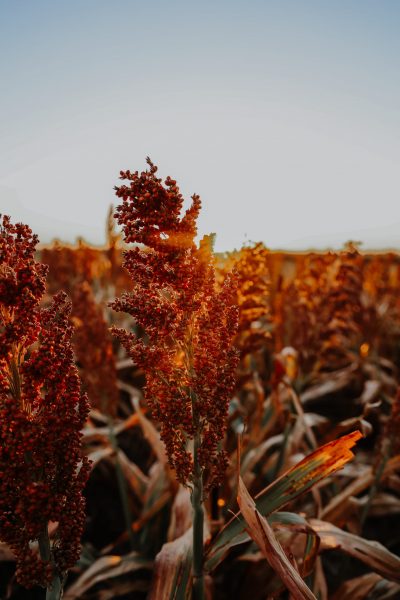Nutrient-packed, non-GMO sorghum addresses water, carbon, soil heath, and economic challenges
Why is a grain that’s 8,000 years old causing a positive stir in the High Plains of the central United States? Why is the fifth most important cereal crop in the world, until recently unknown in America as a food source, being featured as the June Grain of the Month by the Whole Grains Council?
The answer is that sorghum is a naturally non-GMO, gluten-free grain that not only contains an abundance of antioxidants, vitamins, and twice the protein of quinoa, it happens to be extremely drought-tolerant, requiring 30% less water than other grains. In fact, 91% of sorghum acres are rain-fed—dryland farming requires very little irrigation. Saving 1.5 trillion gallons of irrigation water per year, it’s no wonder sorghum is known as the “camel of crops.”
In one 2020 analysis, 95% of the sorghum grown saw a three-ton drop in carbon emissions, and a saving of 10,000 tons of soil from erosion. In the high-temperature/low-moisture environment of the High Plains, sorghum captures 25% more carbon during respiration than grass-based food crops.
Producers and product developers appreciate that the grain has a neutral taste and the “best texture over time in a gluten-free baked good,” noted Karen Watson, director of technical innovation at Nu Life. Nu Life offers proprietary sorghum seeds to farmers and packages varieties of whole grain flours, brans, meals, popped sorghum, and more. Another company, Quinn Snacks, saw its Cheezy Style Pretzel Nuggets win Pretzel Product of the Year from the 2022 Mindful Awards.
Sorghum stats
The U.S. is the top producer of the crop globally, harvesting 373 million bushels in 2020. Kansas and Texas grow the most, followed by Nebraska, South Dakota, Colorado, and Oklahoma. Prior to the last decade or so, U.S. sorghum was grown for livestock feed and ethanol. Today, one-third of U.S. sorghum goes for biofuels, one-third for animal feed, and one-third for food; 6 million acres in 2022 were grown for grain sorghum. In addition, the U.S. exports large amounts —to China in particular.
“The majority of U.S. sorghum is grown on the High Plains since it’s a great fit for the harsh, semi-arid region,” said Adam York, sustainability director at the United Sorghum Checkoff Program, the producer-funded organization supporting the industry.
Sorghum is grown for biomass, for grain, and for its stalk, which produces a sweet syrup favored in the southern U.S. It thrives in the tropics as well as arid regions, maturing quickly (75 days) and often growing to 15 feet tall.
As a “climate smart” and “water smart” resource conserving crop, it appeals to both consumers and producers, York said. Consumers love it as a certified gluten-free, non-GMO, and tasty nutritional powerhouse. For growers, when grown regeneratively it lessens the load of weeds, pests, and soil-borne diseases while saving dollars from reduced inputs. It’s also excellent for wildlife conservation—post-harvest, the stalks provide excellent habitat for pheasant, quail, and pollinators.
Creating a market for a climate winner
Nu Life Market processes sorghum in Scott City, Kansas—the heart of the west Kansas growing region. Working with farmers who use regenerative agriculture, it preserves identity and maintains a Farm to Family Food Safety Program.
“We grow six types of sorghum—white, black, burgundy, waxy burgundy, sumac, and organic,” Watson said. “Supply in the U.S. is stable. Innovations among CPG companies are coming out with products like a vegan milk and yogurt made with our pearled grain sorghum.”
Nu Life was founded by west Kansas farmer Earl Roehmer in 2007. Aware that the Ogallala aquifer was in trouble in the dry High Plains, he traveled the world to find a suitable sorghum for his region. Having identified the best varieties, his team of farmers, food scientists, and nutritionists began creating a market for the crop. “He saw the opportunity for a niche product, and interested farmers were willing to do the work,” Watson added.
In 2020, Nu Life partnered with Sustainable Environmental Consultants to establish metrics and identify crop management practices to reduce greenhouse gas emissions. An analysis of 7,000 Kansas sorghum acres produced data earning a positive rating from NRCS’s Soil Conditional Index (predicting soil organic matter). Overall erosion was 83% lower than the national average.
Sorghum snacks on the rise
In her search for healthy popcorn snacks for her son, owner Kristy Lewis of Quinn Snacks connected with regenerative farmer Steve Tucker. Tucker had grown sorghum for feed as one of 14 non-GMO crops in his 4,000-acre Nebraska farm; he agreed to try to grow it for Lewis’ pretzel product. Though the first crop failed due to weather, he has harvested a second one, currently in R&D.
“Quinn has been using sorghum in its pretzels since 2016 and is grateful to have a gluten-free U.S. source,” said Grace Dennis, sustainability and sourcing manager. “Sorghum’s fairly neutral flavor makes it a good option for baking our seven varieties of pretzels.”
The future of sorghum looks very bright. “Once we explain what it is at the trade shows—touting its drought tolerance and positive environmental impact compared to other grains—it’s very attractive,” said Watson.





